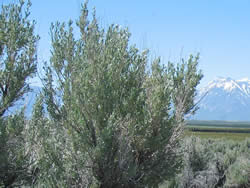USDA Forest Service Celebrating Wildflowers
|
|
|
Plant of the WeekSagebrush (Artemisia tridentata Nutt.)
Sagebrush is an emblem of the mountain West. Its grey leaves and pale yellow inflorescences inspire differing emotions in different people, or even in the same people at different times. I have known people who, on coming to Nevada, have declared it the ugliest land ever to meet there gaze, only to remain there and become enchanted by the silvery carpet of sagebrush covering the hills and mountains there. Artemisia is a generic name honouring the Greek goddess Artemis, known in the West as Diana; many medicinal plants share this genus with sagebrush, such as A. ludoviciana, A. vulgaris, and A. absinthum. The specific epithet tridentata refers to the leaves, which have at the end three "teeth", a useful tool for identification. Look for small, grey, hairy leaves an inch long or less, rather strap-like and shaped like a long wedge. The tip of the leaf should have the three teeth. A crushed leaf will give off the characteristic odour of sagebrush, a somewhat spicy, bitter smell; in areas where sagebrush is the predominant shrub, its familiar scent is almost omnipresent during warmer weather. The stems and twigs are grey; the younger twigs are hairy, and older twigs are covered in a stringy, fragile bark that falls off easily. The trunks of older plants are usually low to the ground and twisted into interesting shapes; in areas with deeper soil and more water, the trunks can be taller than a person and somewhat straighter, though still slightly twisting. The inflorescences are, as described above, composed of small, pale yellow flowers; they appear in late summer on the ends of the branches. There are a few subspecies of this widespread species, and differences in the inflorescence are often helpful in differentiating them. A. tridentata may be found mainly in cold deserts with powdery or sandy soil. It does not take excess water well: streams and riparian areas within the desert often have sharply demarcated edges where the sagebrush ends and the green area begins. It often occurs with western juniper or rabbitbrush. The areas in between the bushes, which are surprisingly bare, are usually filled in with a desert grass such as cheatgrass, Idaho fescue, bluegrass, or bluebunch wheatgrass. Daniel Moerman’s Native American Ethnobotany lists A. tridentata as one of the ten plants with the greatest number of uses. Understanding the reason for this is easy after visiting the area: sagebrush is nearly everywhere. Tea was made from various parts of the plant, and it was used extensively in medicine. The wood was used as fuel, and the stringy bark was used in the manufacture of ropes and baskets. Besides practical uses, sagebrush has a symbolic value, especially in Nevada, where it covers most of the State. Sagebrush is the official state plant, is featured on the state flag, and is even mentioned in the state song. Natives of the West who are poets or writers often remember the plant fondly in their writings, if for nothing more than sentimental value: although fairly good forage, it is rarely eaten by wildlife or livestock because of the bitterness of its foliage. For More Information |
|
| NOTE: PDF format links require the Adobe Acrobat Reader to view. | |
| top | Disclaimers | FOIA | Privacy Policy | Quality of Information | Photo Credits & Use |
Location: http://www.fs.fed.us/wildflowers/plant-of-the-week/artemisia_tridentata.shtml
Last modified: Tuesday, 24-Jun-2008 21:55:01 EDT




